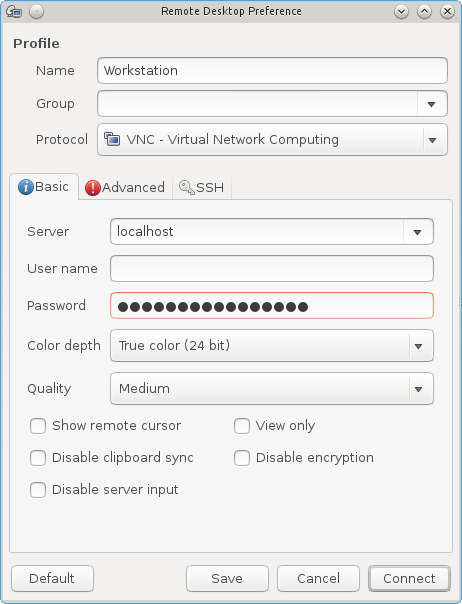

- #VNC THROUGH SSH TUNNEL X11VNC INSTALL#
- #VNC THROUGH SSH TUNNEL X11VNC FULL#
- #VNC THROUGH SSH TUNNEL X11VNC SOFTWARE#
- #VNC THROUGH SSH TUNNEL X11VNC PASSWORD#
- #VNC THROUGH SSH TUNNEL X11VNC PC#
#VNC THROUGH SSH TUNNEL X11VNC PC#
VNC or other remote desktops, if set up correctly to run on the Jetson, but merely forward to a client on a PC will do the job. The remote desktop client understands the forwarded desktop rather than the events.
#VNC THROUGH SSH TUNNEL X11VNC SOFTWARE#
A purely software virtual desktop still runs on the Jetson, and events are still interpreted by the “local” desktop, but then the desktop itself has the result of events forwarded instead of the actual event. This is virtual desktop software, e.g., Vino, which has this function. If you want the requirement to be part of the Jetson, and not be offloaded to the PC, then it implies your software producing X events must all run and be interpreted on the Jetson without “forwarding” of events to a different computer. If you do not forward, then the Jetson needs EGL support once you forward, it is the other computer which provides the GPU and EGL support. If those events include EGL requirements, then the system actually providing the display is the one which needs that support. ssh forwarding forwards events, and the events are what cause various graphics or mouse or keyboard actions to have meaning. The gist is that ssh forwarding is very different versus a desktop which is virtual with the desktop itself being forwarded. I’ll post a couple of related URLs, YMMV:
#VNC THROUGH SSH TUNNEL X11VNC FULL#
NOTE : expanding this window to full screen is sometimes required to ensure that the position of the mouse pointer matches the screen coordinates clicked.You should know that “ ssh -X” (or “ ssh -Y”) probably does not do what you think it does. You can now start topspin or vnmrj (or any other application installed there).
A new window will appear with the desktop from the spectrometer computer. #VNC THROUGH SSH TUNNEL X11VNC PASSWORD#
The next password requested (in a pop-up window) is the VNC password. 
 You will be prompted (in the terminal) to enter your NMRFAM password. Enter the NMRFAM spectrometer computer and VNC server number started in step 1 above (e.g. Start the program “TigerVNC Viewer” with the ‘-via’ option to tunnel through login1 (or login2):. Replace 1.XX.XX.app with the installed version of TigerVNC (e.g. Navigate to the Mac OS-X subfolder of TigerVNC :Ĭd /Applications/TigerVNC\ Viewer\ 1.XX.XX.app/Contents/MacOS. Open a terminal window: Launchpad > Other > Terminal
You will be prompted (in the terminal) to enter your NMRFAM password. Enter the NMRFAM spectrometer computer and VNC server number started in step 1 above (e.g. Start the program “TigerVNC Viewer” with the ‘-via’ option to tunnel through login1 (or login2):. Replace 1.XX.XX.app with the installed version of TigerVNC (e.g. Navigate to the Mac OS-X subfolder of TigerVNC :Ĭd /Applications/TigerVNC\ Viewer\ 1.XX.XX.app/Contents/MacOS. Open a terminal window: Launchpad > Other > Terminal #VNC THROUGH SSH TUNNEL X11VNC INSTALL#
Install TigerVNC on your Mac OS-X computer. Scroll down to the Mac OS-X section and download latest version of TigerVNC. If you don’t have it already, download and install TigerVNC : On your Mac OS-X computer we are going to use TigerVNC to connect to the VNC server running on the spectrometer computer. Access the VNC server from your Mac OS-X computer. NOTE: If you are not “physically” logged on the spectrometer computer you will get an error message when using x11vnc. ssh to the spectrometer computer (e.g. Open a terminal window on your computer: Launchpad > Other > Terminal. NOTE : you must also be “physically” logged into the spectrometer computer. Start the VNC server on the spectrometer computer remotely from your Mac OS-X computer. IMPORTANT: do NOT close the terminal window as this will kill the VNC server you just started. If you do not wish to use a password for the VNC server, replace the -usepw option with -nopw. To reset the VNC password, login to the spectrometer computer as shown above and type vncpasswd (it doesn’t ask you to input the old password to change it, so it’s not a problem if you forget it). The VNC password is different from the login password. Note that with this command the VNC server is protected by a password. Take note of the VNC server (or desktop) number that was started (e.g. X11vnc -display :0 -usepw -shared -forever -noxdamage Start the VNC server directly on the spectrometer computer before leaving the lab. This can either be done directly on the spectrometer computer or remotely from your computer. Start a VNC server on the spectrometer computer. IMPORTANT : only the person that is “physically” logged into the spectrometer computer can use x11vnc to start a VNC server to connect to the spectrometer desktop. If you are logged on the spectrometer computer, you can use x11vnc to connect to the spectrometer computer desktop. Use x11vnc to connect directly to the spectrometer computer desktop from your Mac OS-X computer







 0 kommentar(er)
0 kommentar(er)
